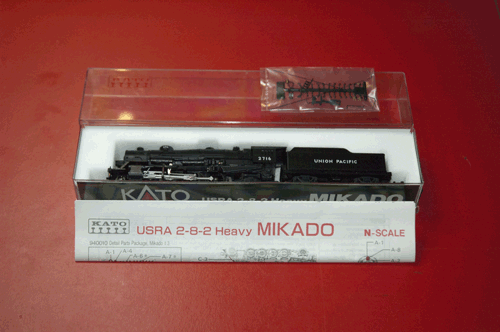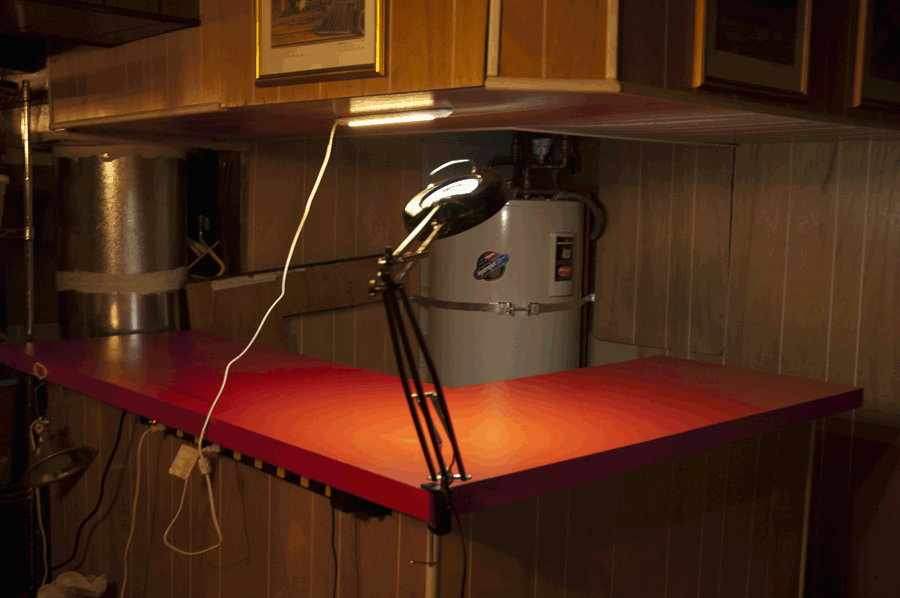
The first job was to unpack and survey my models and supplies. I already knew we took a loss a few years ago when a box of stuff got crushed. A couple of locos and a bunch of rolling stock are gone for sure. I hadn’t had the heart to check the rest until now. What is it they used to say in the Army? Three moves are as good as a fire.
Thankfully the good condition of the remaining boxes did not hide a disaster inside. My Kato 2-8-2 Mikado, just purchased, not yet detailed and barely tested when last packed 15 years ago, is in perfect condition.
My much abused Trix 0-6-0 is still with me and in need of several repairs which I hope to attempt when some material gets here from Micro Mark. A flea market Bachmann U36B looks like it should run though it won’t fit on a transition era layout. No matter.
The built structures survived, mostly, and the kit collection is ready to go. I still have some unused track collected 15 years ago for another layout that was never built: 25 pieces of Peco code 80 flextrack and 7 unused Peco Code 80 turnouts, and one wye, are a very good start. I may play with some code 55 for sidings, branch lines and the like, but I think I’ll stick to code 80 otherwise for this go.
It’s been a while since I had any space available. Basements are not all that common in Reno (tough ground to dig for starters), and it seems that carving space out of a bedroom or garage is always impossible. Our current home has a basement; but it is all pretty much in use as living and working space. The utility room is actually a substantial space; finished out as recreation space with a classic 70’s vintage bar area, and cheap wood paneling everywhere. We use the room for storage, and floor space is lacking because of that. A substantial layout is impossible without moving all the storage elsewhere, and as renters that’s probably more layout than we’d want to contend with anyway.
But then, thinking differently, I started looking at the bar as an opportunity:
It’s difficult space for obvious reasons. Low headroom, no light and you can see from the picture that getting light in there will be challenging because I have to take the space as it is. No modifications to the space allowed.
On the other hand, the bar is a perfect table/support for a layout. The surface is a generous 82″ x 66″ L, 27.5″ wide all around. Its almost completely walk-around. This is a doable space for N scale. The counter is 40″ off the floor, which I think is a good height to work from. I won’t need a a leg system for setting up on the bar; setting up the layout in other locations will require portable tables or some other support. I have a concept for separate, portable support loosely based on L-girder design. Perhaps in the future, but for now I’m going to embrace the bar, so to speak.
So this was my first time ordering from Micro-Mark. Remember how I said that I have to be able to get materials locally or online within a week? Well, forget that one with Micro-Mark. It was only after finding some items for the shopping cart that I discovered that their policy is that it takes 2-3 days to prepare a shipment. No 1 business day turnaround here. And the choices for shipping methods leave much to be desired. Hmmm. Having not shopped for hobby supplies via the Internet before, I don’t know what the norms are for this sub-industry. I’ve already received a small order from Digi-Key placed on the same day. I’ll let you know what I think of this experience after the goods arrive.
That prompted me to grab my wife and trot over to our local Michaels in search of quilter’s T Pins (Woodland Scenics markets a version of these as “Foam Nails”) and to conduct a stock survey. Michaels is a quirky place, but they are well set for the basics: glues, art supplies and tools, and a wide range of jewelry making and crafting supplies. Maybe I won’t be as dependent on Micro-Mark as I thought.
I should note that Reno used to have a well-stocked hobby store that was primarily rail oriented. The other stores here focus on other hobbies like R/C and Military modeling. The owner of the rail store was older and looking to retire some years ago and I think he successfully sold it. The store did not survive the Great Recession, however, so specialized model railroad support is lacking here. Having lived in Baltimore MD for a time and worshiped at the shrine of MB Klein while they were downtown, I have very high standards for a Model Railroad shop. For better or worse, I’m largely dependent on the Internet for parts and supplies.
Anyhow, having unpacked and done some basic organization, the first order of business is to create a test loop; well more than that really, a test module where I can do a first test of some intended materials and techniques including eventual turnout and block detection systems. Right now, I need to test the locos and rolling stock and find out what needs to be fixed or replaced.
I’ll tackle that next time.

